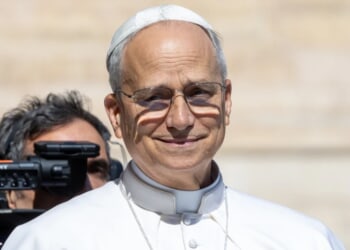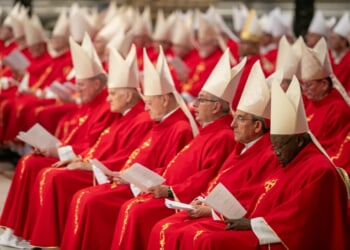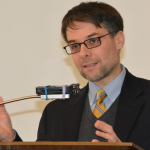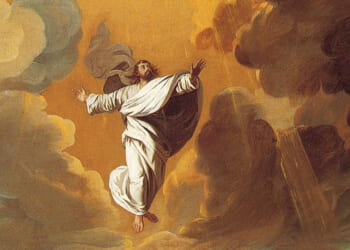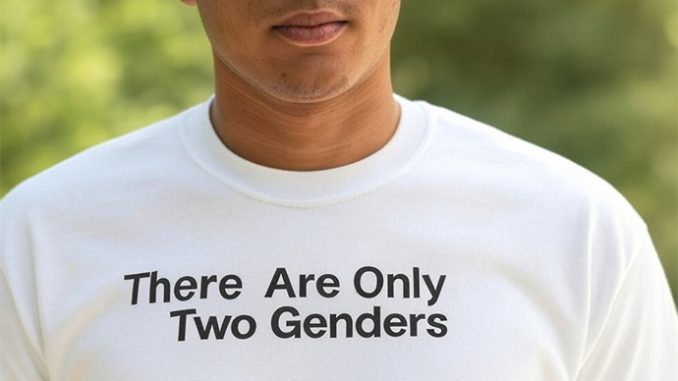
On May 27, 2027, the Supreme Court, over dissents by Justices Thomas and Alito, refused to hear an appeal after public school officials suppressed student speech with which they disagreed. The Court was unwilling to review the First Circuit’s order in L.M. v. Town of Middleborough, Massachusetts, affirming that educators could prohibit a student from wearing different versions of a t-shirt displaying the message “There Are only Two Genders.”
In light of L.M.’s negative effect on student free speech and possible impact on religious expression in public schools, this column briefly reviews the case’s history before reflecting on its potential impact.
L.M. v. Town of Middleborough, Massachusetts
L.M. v. Town of Middleborough, Massachusetts began in the spring of 2023 when a twelve-year-old, seventh-grade honors student wore a t-shirt proclaiming “There Are only Two Genders.” Officials ordered L.M. to “to change his shirt or go home” because they believed it violated the school dress code, according to which “[c]lothing must not state, imply, or depict hate speech or imagery that target groups based on race, ethnicity, gender, sexual orientation, gender identity, religious affiliation, or any other classification.”
When L.M. later wore a t-shirt with the words “Only Two” covered by tape on which he wrote “CENSORED,” officials again told him to change it or go home. L.M.’s parents unsuccessfully challenged the dress code as violating his First and Fourteenth Amendment rights to free speech and due process, respectively.
On appeal, because the First Circuit thought that since officials fairly interpreted the t-shirts as demeaning toward transgender-gender-nonconforming students, allowing L.M. to wear them would have been materially disruptive, it unanimously affirmed in their favor. Other than “a few complaints,” though, there were no disruptions. Officials feared the messages “would ‘poison the educational atmosphere and so result in declines in those students’ academic performance and increases in their absences from school,” Further, the court agreed the dress code was neither vague in violation of L.M.’s Fourteenth Amendment due process rights nor over-broad under the First Amendment free speech clause.
As indicated, the Supreme Court refused to hear an appeal.
Analysis and reflections
It is unclear how suppressing L.M’s First Amendment right to express the biblical view that “[w]hen God created human being…he created them male and female” either violated the school’s ill-defined dress code or respected his religious beliefs. The Roberts Court’s refusal to intervene is a significant setback for student free speech.
Justice Thomas acknowledged in his brief, two-paragraph dissent that any discussion of student speech must harken to 1969’s Tinker v. Des Moines Independent school District, the seminal decision on this important issue. The Tinker Court ruled that students could wear black armbands to school to protest American involvement in Vietnam. Recognizing that “[i]t can hardly be argued that either students or teachers shed their constitutional rights to freedom of speech or expression at the schoolhouse gate,” the Justices held that “where there is no finding and no showing that engaging in the forbidden conduct would ‘materially and substantially interfere with the requirements of appropriate discipline in the operation of the school,’ the prohibition cannot be sustained.”
In his almost fourteen-page dissent, Justice Alito, joined by Justice Thomas, offered two reasons why he would have heard an appeal. “First, we should reaffirm the bedrock principle that a school may not engage in viewpoint discrimination when it regulates student speech.” Secondly, “we should also grant review to determine whether the First Circuit properly understood the rule adopted in Tinker regarding the suppression of student speech on the ground that it presents a risk of material disruption,” because there was none.
Alito highlighted that “[a]bove all else, the First Amendment means that government has no power to restrict expression because of its message, its ideas, its subject matter, or its content,” adding “[n]or is there a carveout from this principle for controversial, offensive, or disfavored views.” Criticizing the First Circuit, Alito noted that “[i]nstead of applying Tinker’s speech-protective standards, the court below crafted a novel and permissive test that distorts the ‘material disruption’ rule beyond recognition…[it] identified a special category of speech, i.e., speech that can be interpreted as demeaning a deeply rooted characteristic of personal identity.”
Alito concluded his prescient dissent by observing that “[s]o long as the First Circuit’s opinion is on the books, thousands of students will attend school without the full panoply of First Amendment rights.”
Addressing the importance of free speech, in a 1989 decision permitting burning the American flag, the Supreme Court emphasized that “[i]f there is a bedrock principle underlying the First Amendment, it is that the government may not prohibit the expression of an idea simply because society finds the idea itself offensive or disagreeable.”
Regrettably, in L.M. the Roberts Court ignored that “provocative and challenging speech” is most in need of the protections of the First Amendment. Popular speech is not likely to provoke censure. It is unpopular speech that invites censure. Another court commented that “unpopular speech…needs the protection of the First Amendment. The First Amendment was designed for this very purpose…” because “Individual student speech which is unpopular but does not substantially interfere with school discipline is entitled to protection.”
It is also unclear why Middleborough officials “promote[d] messages commonly associated with ‘LGBTQ Pride’ [while]…observ[ing] events like ‘Pride Month,’ and ‘Pride Day’ in support of the ‘LGBTQ+ community’ [and permitting] a Gay Straight Alliance Club since at least 2018, ‘[t]o further the goal of providing support to students who are part of the LGBTQ+ community’” while disallowing L.M.’s perspective.
Unfortunately, the Court refused, without offering a rationale, to hear an appeal as educator-activists imposed the politically correct orthodoxies of the day by censoring L.M.’s viewpoint with which they disagreed, even though his t-shirts did not violate Tinker’s prohibition against disruptions. In the process, the courts essentially aided and abetted officials who trammeled L.M.’s free speech rights.
Unfortunately, cases such as L.M. are “capable of repetition yet evading review,” meaning similar litigation is likely to arise without judicial clarifications on the limits of educator authority to prevent students from expressing differing opinions. The Supreme Court must intervene in such a dispute to safeguard freedom of speech, perhaps the most cherished of American constitutional rights.
Another important aspect of L.M. is freeing students from compelled speech, an approach the Supreme Court has adopted for non-unionized public employees and others. The Justices need to address the behavior of officials such as those in Middleborough who sought to compel L.M. to avoid communicating messages other than those with which they agree by forbidding him from expressing his beliefs freely and passively on his t-shirts. These officials ignored biological reality and biblical truth on human sexuality, basically indoctrinating children by denying them access to differing outlooks.
The Court must safeguard the free exchange of ideas because “America’s public schools are the nurseries of democracy. Our representative democracy only works if we protect the ‘marketplace of ideas.’ This free exchange facilitates an informed public opinion.”
If you value the news and views Catholic World Report provides, please consider donating to support our efforts. Your contribution will help us continue to make CWR available to all readers worldwide for free, without a subscription. Thank you for your generosity!
Click here for more information on donating to CWR. Click here to sign up for our newsletter.


